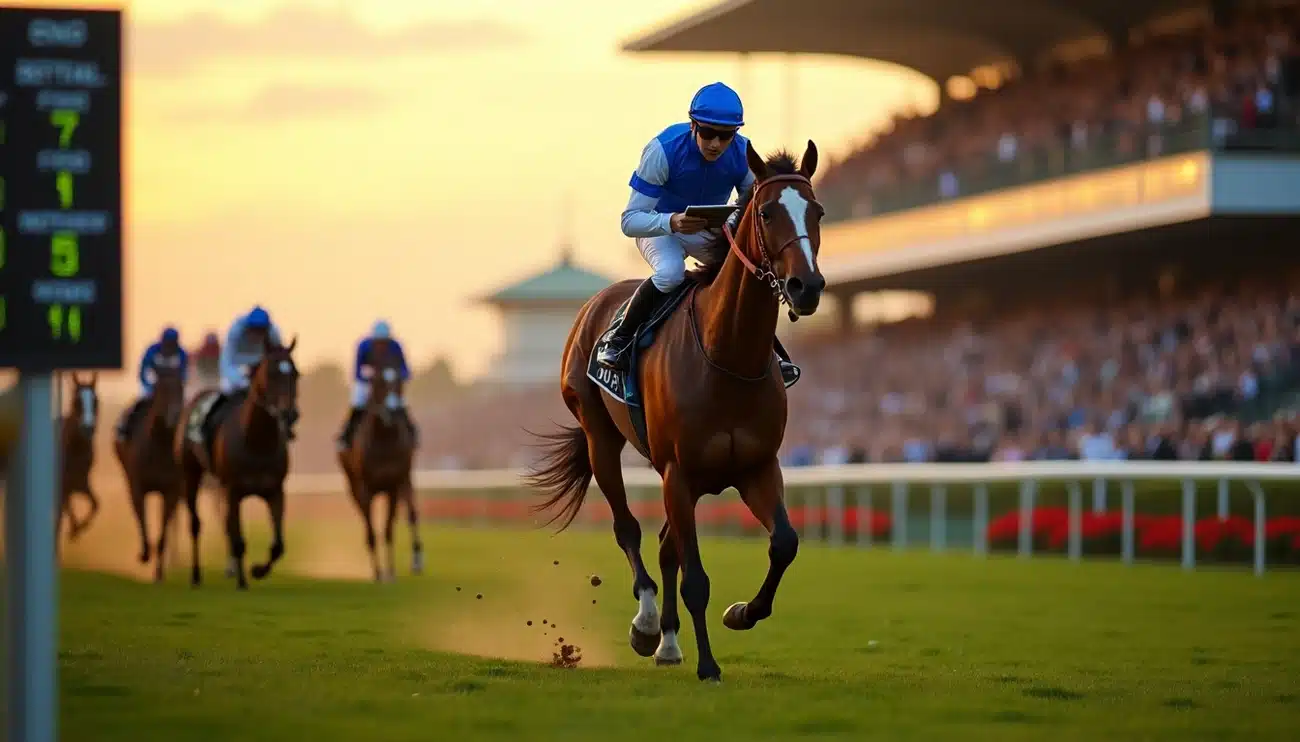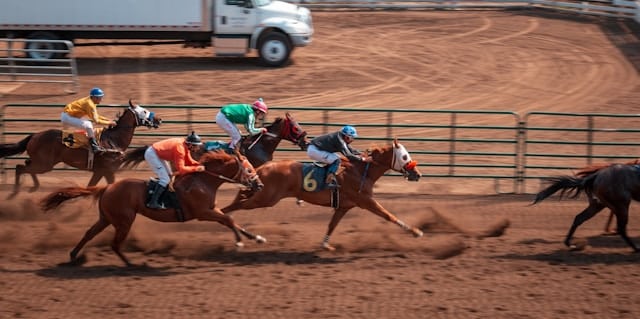Are you looking for free horse racing systems? Look no further. In this guide, we will give you some top-class tips.
Did you know that only 34.4% of favourites have won their races over the last five years in UK horse racing? That’s right — even the bookies’ top picks lose almost two-thirds of the time!
My years of testing free winning horse racing systems led me to find that there was something remarkable: around 40% of favourites are actually “false favourites,” and they go off at shorter odds than they should. This creates a golden chance for smart bettors.
The right approach to backing favourites can lead to long-term profits. During the 2021 flat season, odds-on favourites won approximately 58% of their races, though with a 6.73% loss on investment. Being selective makes a significant difference.
Research dating back to the late 1940s shows that bettors tend to overvalue longshots and undervalue favourites — it’s called the “favourite-longshot bias.” Longshots (20/1 & bigger) had a dismal 1.64% strike rate with a 41% loss on ROI in 2021. Yet, certain systems that target second favourites in specific race types have shown a 25% strike rate with 17% profit.
The best part is that you don’t need complex formulas or expensive subscriptions to win at horse racing. Simple horse racing systems that work are based on fundamental principles that anyone can follow. In this piece, I’ll share the proven systems I’ve personally tested that can reshape your betting approach in 2025.
Why Favourites Still Matter in 2025
Many bettors don’t realise that favourites are the lifeblood of profitable horse racing systems in 2025. The data shows why they should be central to any simple winning system for horse racing.
The strike rate of favourites in UK races
The numbers paint an interesting picture about how favourites perform. Favourites in UK races managed to keep a steady win rate of 35.19% in the last decade, with data from 88,921 races. This means a favourite wins just over one in three races – a pattern that hasn’t changed much through the years.
Race types show different winning patterns:
- Favourites win about 39% of handicap races
- They win only 26% of non-handicap races
- Odds-on favourites win 53% of handicap races
- Odds-on favourites win an impressive 61% of maiden stakes races
The shorter the odds, the better the chances of winning. Favourites priced at 1/4 or shorter win about 86% of their races. Second favourites win between 18-21% of races. This means either the favourite or the second favourite wins about half of all races.
Monthly data from 2024 reveals some patterns. February brought the highest winning rate for favourites at 41.07%. May showed the lowest at 33.52%. These seasonal changes give an explanation about developing systems that work year-round.
Common myths about betting on favourites
Horse racing systems often fail because of these persistent myths about betting favourites:
Myth 1: Always bet on the favourite
Betting on every favourite blindly won’t make you money. Backing all clear favourites in UK races would have lost you 2.69% of your money in the last decade. Professional handicappers say about 40% of favourites are “false favorites” – horses that people think have better chances than they actually do.
Myth 2: Favourites are always the safest bet
Favourites might win more than any other horse, but they lose almost two-thirds of their races. Even odds-on favourites lose about 40% of the time. Smart bettors look at multiple factors beyond market position.
Myth 3: You need insider information to beat the favourites
Evidence-based analysis and historical performance data are better than “tips” or insider knowledge. A daily horse racing system based on solid statistical analysis of favourites and race conditions beats most insider tips.
Myth 4: Favourites perform consistently
Horses don’t always perform the same way. Track surface, weather, race distance, and other horses affect a favourite’s chances. Understanding these factors helps create a winning horse racing system.
These insights show that the secret to making money from favourites isn’t avoiding them. The key lies in developing a systematic way to find favourites that offer real value. Let’s explore why blindly backing favourites causes problems and how you can avoid this common mistake.
The Problem with Blindly Backing Favourites
Betting only on favourites might look like an easy way out. Research shows this approach results in steady losses over time. Even though favourites win more often than other horses, the numbers just don’t add up in your favour.
Understanding false favourites
False favourites create one of the biggest traps in horse racing betting. Market makers set these horses as favourites with deliberately wrong prices to trap bettors who blindly back favourites. Professional handicappers say about 40% of all favourites are “false favourites” – horses whose real chances are substantially overvalued by the betting public.
Several factors create false favourites:
Media influence: Media coverage plays a huge role. The media tends to overhype horses that win their latest race, which creates excessive buzz among bettors. This happens more often at smaller midweek meetings than at major events, where market forces work better.
Last-start winners: Many casual bettors think a horse that won its last race can win at any level. These last-start winners often become overbet favourites despite clear warning signs.
Poor jockey-trainer combinations: Jockeys with low strike rates or trainers winning less than 6% of races often point to a false favourite. New jockey-horse partnerships also lack the teamwork needed for peak performance, yet bettors still make them favourites despite these red flags.
Course and distance factors: A favourite without proven results at a specific track or distance is another classic false favourite case. FlatStats data shows that at tracks like York and Ayr, favourites win only about 28% of races. Blind backing at these venues can get pricey.
Yes, it is true that if you had backed every favourite at Ayr with £1 stakes, you would have lost £166.88 across more than 300 races. The math simply doesn’t support this random approach.
How the favourite-longshot bias affects odds
The sort of thing I love about betting psychology is the favourite-longshot bias, first discovered in 1949. Bettors tend to overvalue longshots while undervaluing favourites. This bias creates a key market flaw that shapes the odds.
The numbers tell the story: backing favourites loses around 5.5%, while horses at odds between 4.0 and 16.0 lose nearly 18%. Even more dramatically, longshots at 40/1 and higher can lose over 40% of investment value in the long run.
Bookmakers exploit this pattern. They don’t spread their margins evenly across all horses. They put much higher margins on longshots while keeping favourites’ margins relatively small. Take tennis betting – bookmakers might use a 1% margin for the favourite but bump it to 11% for the underdog.
This happens because:
- Bookmakers know casual bettors love the idea of big payouts from longshots
- Average bettors can’t really judge the true chances of a 20/1 shot
- Favourites get more attention and price comparison from bettors
Most bettors also lack the discipline to manage their bankroll when backing favourites. A casual punter might bet £10 on a 5/1 shot but would need much bigger stakes on short-priced favourites for similar returns.
The answer isn’t to avoid favourites completely. The key is to develop a simple winning system for horse racing that spots real value in favourites while avoiding false ones. Using specific filters can turn random betting into a free winning horse racing system that works long-term.
How to Filter the Right Favourites
Systematic filtering helps you tell winning racing systems from losing ones. I’ve created a three-part filtering process that makes selection quality better by a lot after spotting false favourites.
Avoiding poor jockey-trainer combos
The jockey-trainer relationship makes a huge difference in race outcomes. Professional punters know this partnership is vital to success. Here’s what to look for in favourites:
- Look for combinations with 30%+ win rates and positive profit figures
- Stay away from favourites with jockeys who rarely win at specific tracks
- Skip favourites from trainers with win percentages below 6%
- Be careful with trainers who send horses to distant tracks
Research shows that top trainers pick specific jockeys when they have horses ready to win. Even the best jockeys can’t make poorly trained horses perform better, whatever their skill level.
Checking the course and going suitability
A horse’s track record is vital to spot real favourites:
- Skip favourites that haven’t won at the specific track
- Pass on favourites that haven’t shown they can handle the current going conditions
- Watch out for favourites racing at tracks where they’ve done poorly before
The going classifications (firm, good to firm, good, good to soft, soft, heavy) have a big effect on performance. Smart bettors keep an eye on weather forecasts because sudden going changes can create risks and opportunities for value bets.
Using draw bias to your advantage
Starting stall position can make or break shorter races:
- Chester’s tight circuit gives low-drawn horses a clear edge
- Beverley’s stalls 1, 2, 4, and 6 produce approximately half of all winners
- High draws work better at Lingfield in 5-7 furlong races
- Thirsk’s high-drawn horses do better, especially in sprints
- Ascot usually favours high draws along the stands side
Going conditions change how the draw advantages work. Smart punters look at stall positions near the rails when heavy rain makes the ground soft.
These three filtering criteria help create a simple winning system for horse racing. Your strike rate could jump from 33% to 55% by avoiding weak favourites. You won’t need complex algorithms or paid subscriptions either.
A Simple Winning System for Horse Racing
A simple three-step system has emerged from our analysis of favourites. This approach delivers consistent results without complex math or paid subscriptions.
Step 1: Start with the favourite
Your original focus should be the race favourite. The numbers tell us that all but one of these races go to the first four favourites. This fact is the foundation of any profitable strategy. Favourites give you much better chances of winning than random picks.
The best results come from:
- Clear favourites (not joint or co-favourites)
- Favourites priced between 6/4 and 8/1 to get the best value
- Favourites in races with 8-12 runners
The statistics show an 80% tide against you when looking beyond the first four favourites. The market leader puts the odds in your favour.
Step 2: Apply the 5-point rejection filter
This vital filtering system helps you spot false favourites. A favourite should be rejected if it fails any of these criteria:
- Jockey-Trainer Quality: Skip favourites without top jockeys or from stables that win less than 6%
- Course Form: Pass on favourites that haven’t proven themselves at this track
- Going Suitability: Avoid favourites not tested on today’s ground conditions
- Draw Position: Skip favourites with poor starting positions based on course bias
- Recent Form: Passed on favourites without a top-three finish in their last race
This method turns random betting into a well-laid-out strategy. Each filter spots specific weaknesses that often cause favourites to fail.
Step 3: Only bet when all criteria are met
Discipline is the lifeblood of every winning betting strategy. Place bets only when the favourites pass all five rejection filters. You’ll bet less often, but this approach guides you to better long-term results.
The core principles are:
- Keep detailed records of results
- Set aside a specific bankroll just for this system
- Never chase losses by lowering your standards
- Look for non-handicap races to find better value
Discipline sets winners apart from casual bettors. Professional punter Barry Blakemore points out that 75-80% of winners come from the first four favorites. This makes the system logical and backed by statistics.
Choosing the Right Races to Bet On
Race type selection affects your betting success rate more than picking horses. A good selection method paired with the right race categories can boost your wins.
Why non-handicap races offer better value
Non-handicap races give better chances for favourite backers. The numbers show favourites win about 43% of non-handicap races but only 29% of handicaps. This 14% gap makes a huge difference for serious bettors.
The numbers look even better when we break down specific types:
- Maiden Stakes races: 43% favourite strike rate
- Novice Stakes races: 44% favourite strike rate
Maiden, novice, and beginner races offer the best returns. A professional bettor puts it straight: “My advice is to focus on maiden, novice and beginner races” that bring steady profits.
How to use course stats to your advantage
Course features greatly shape favourite performance. The complete data shows York, Newbury and Ascot have the country’s lowest favourite success rates. Sandown, Thirsk and Catterick show the highest strike rates.
Some jockey-course combinations produce amazing results:
- Nicky Henderson’s horses shine at Newbury and Kempton
- Paul Nicholls does great at West Country tracks like Wincanton, Taunton and Exeter
Some venues have specific patterns you can use. Uttoxeter’s hurdler favourites hit a 40% strike rate while fence favourites only reach 32%.
Avoiding races with low favourite strike rates
Some race types just don’t work for favourites. Two-year-old handicap races at Leicester show only 10% favourite wins “because Leicester is one of the stiffest sprints and finishes in the country”.
Flat turf handicap favourites win just 27% of races. These races make poor betting choices unless special conditions exist.
Class plays a big role, too. Southwell’s Class 4 and 5 hurdle favourites hit an impressive 50% strike rate with roughly 25% ROI. These races offer great value in an otherwise tough betting scene.
Free Horse Racing Systems – The Conclusion
Simple horse racing systems that work don’t need complexity or high costs. This piece shows how backing favourites with a systematic approach can lead to steady profits. Random betting on every favourite will drain your bankroll. A careful selection process turns random betting into a winning strategy.
The system works because it tackles the biggest problems most bettors don’t deal with very well. Anyone can follow the three-step approach: start with favourites, use the 5-point rejection filter, and stick to strict discipline. So your win rate could improve substantially without paid subscriptions or complex algorithms.
Success depends on spotting races with real value. Non-handicap races deliver higher favourite win rates than handicaps, especially when you have maiden and novice stakes. On top of that, track features affect results heavily, making venue choice as vital as picking horses.
One of the first four favourites wins about 80% of all races. Your betting strategy should work with these odds instead of against them. Some favourites will lose, but good filtering shows which ones deserve your money.
The system combines mental discipline with proven statistics. About 40% of all market leaders are false favourites, but the 5-point rejection filter helps you avoid these pitfalls. Without doubt, keeping detailed records will show how well the system works as patterns become clear over time.
Betting on horses remains tough, but this direct approach makes regular profits possible for regular bettors. These methods have proven their worth through years of testing, and they’ll work for you in 2025 and beyond.
Free Horse Racing Systems – Your FAQs
Q1. What is the most effective approach to betting on horse racing favourites? The most effective approach is to start with the favourite, apply a 5-point rejection filter (considering jockey-trainer quality, course form, going suitability, draw position, and recent form), and only bet when all criteria are met. This systematic method helps eliminate false favourites and improves your chances of success.
Q2. Which types of races offer better value for betting on favourites? Non-handicap races, particularly maiden and novice stakes, offer better value for betting on favourites. These races have a higher favourite strike rate (around 43-44%) compared to handicap races (about 29%). Focusing on these race types can potentially increase your winning percentage.
Q3. How important is course selection when betting on horse racing? Course selection is crucial in horse racing betting. Different tracks have varying favourite success rates, and some venues feature specific biases. For example, favourites at Sandown, Thirsk, and Catterick tend to perform better than those at York, Newbury, and Ascot. Understanding these course characteristics can significantly impact your betting success.
Q4. What is the “favourite-longshot bias” in horse racing betting? The favourite-longshot bias is a phenomenon where bettors tend to overvalue longshots and undervalue favourites. This creates a market inefficiency where backing favourites typically loses at a lower rate (about 5.5%) compared to backing longshots, which can lose over 40% of investment value long-term. Understanding this bias can help inform more strategic betting decisions.
Q5. How can I improve my horse racing betting discipline? To improve betting discipline, maintain meticulous records of your results, set aside a specific bankroll solely for your betting system, never chase losses by lowering your standards, and focus on races that offer better value (like non-handicaps). Consistently applying a systematic approach and avoiding impulsive bets are key to long-term success in horse racing betting.



